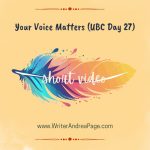How can we choose to improve our writing voice?
I know when I was teaching writing to my students, voice was one of the hardest writing traits to teach and learn. Over the years, I studied and read as many teaching resources I could find on how to teach voice. Until one day, while attending an SCBWI conference in Syracuse, something clicked.
The presenter (sorry, it’s been years since, I don’t remember the name) focused on the first lines of books, those that packed a punch. We read them together, we analyzed together, and we heard an audible response to each first line from the crowd. I remember learning so much that day. And I though how can I bring this back to my classroom?
Around the same time, I read a teacher resource book that talked about focusing on Golden Lines. (will insert book title here when I find it) Golden Lines are a selection of exquisite sentence(s) that we used as mentor text to study exemplary writing. I limited the lines to approximately 15 – 20 words. Once we practiced selecting and responding to the lines, we mimicked the structure of the sentences using our own content. It was a little bumpy at first, as anything is, but as we went along, I was surprised how quickly most students improved in their revisions. It was a real pleasure reading their work by the end of the year as they practiced and practiced using the Golden Lines as mentor texts. I was so proud of their improved voices!
Picture Books in the Middle School Setting
During this process over the last couple years of my teaching career, I also practiced alongside my students, sharing my work with them. I also noticed improvement in my writing as we analyzed lines of writing from many picture books. Yes, picture books in a middle school setting – why? I explained to my kids that picture book writers have a difficult job of telling an entire story in 500 words or less, so every word they choose counts. I think picture book writers are master teachers of writing, which I shared this idea with my students, and they dove right in. By the end of my 34 years of teaching, I had quite a collection of 100+ well-used (and loved) picture books in my collection. (*It should be noted, we also studied Golden Lines in novels too, but picture books were easier to manage within 50 minutes)
SCBWI Writing Workshops
In addition, I continued on my own author journey and took another SCBWI course with author Darcy Pattison. This time the course focused on voice, which included word choice and sentence structure. Wowie – Did things start to click! At the end, Darcy provided a list of books for further reading. More teaching resources!
Since then, author Linda Sue Park mentioned character voice at a couple of local SCBWI conferences I attended. She explained that voice equals word choice plus rhythm (rhythm is the same as sentences and punctuation). She guided us through several revision exercises that helped improve our works-in-progress. Again, wowie!
How I Chose My Niche
Fall was a transition time for me. I realized I missed digging into exquisite writing with my classes. I know I became more knowledgeable as I taught certain content year to year. So analyzing golden lines for the Art of Author’s Voice seemed like a perfect fit, a perfect focus. And that’s how I chose my niche. It’s something I’ve always done – reading, researching, analyzing, growing – I want to boost my writing too! I hope to help others on their journey and that’s why I’m focusing to choose to improve writing voice in my newsletter. My posts will include writing voice topics as well as Native American content and tips for children’s authors too.
The Difference between Imitation and Plagiarism
The book titled IMAGE GRAMMAR by Harry Noden explains (p79):
“Imitation of structure improves writing because the writer is internalizing the structural design, not the content…this is analogous to a guitarist who learns a variety of musical elements like blues scales and riffs that every blues musician knows, then uses that knowledge to create original songs. The difference between imitation and plagiarism: imitation emulates techniques that produced artwork while plagiarism attempts to duplicate the entire piece.”
3 Ways to Study Structure and Improve Writing Voice
It’s important to know there are different approaches to studying mentor texts passages, or Golden Lines, in order to improve writing.
Approach #1
- Identify a short passage of exquisite writing.
- Read carefully (outloud) – What do you notice?
- Analyze the structure – word choices, organization, sentence length, etc.
- Imitate the model’s style, but change the content.
Approach #2
- Read the passage you selected to study.
- Analyze and make a bulleted list of content, then put the passage away.
- The next day, use your bulleted list and recreate the passage.
- Compare – original and your new version. Why is the original more effective? What was overlooked in the imitation?
- Create a similar passage using your own content trying to evoke the same image effect.
Approach #3
- Select an exquisite passage using a professional author’s work.
- Analyze the sentence structure for active, direct sentences and concise, direct verbs. How does the “scene” unfold?
- Use your own content and imitate the structure.
Choose to Improve Writing Voice
I’d love to help other children’s writers improve their writing voice. I’d love to help teachers and librarians with classroom writing tips to guide students to improve their writing voice. We’ll explore the three approaches above to imitate exemplary writing. I’ll be posting here and in my Art of Authors Toolbox newsletter. I hope you join me on this journey so we can learn together.
Yay Team!
















